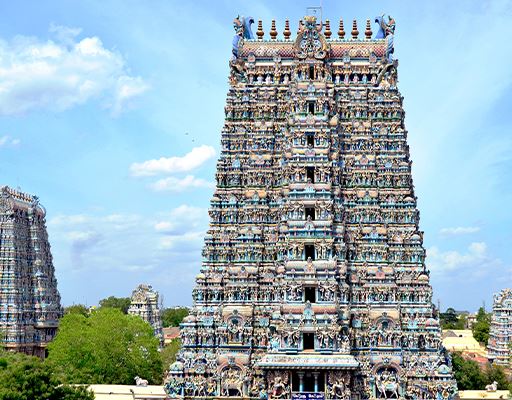Sacred Art: Multiplicity at Hindu Meenakshi Temple
Hinduism, one of the oldest and largest “religions” practiced today, is entirely different from the Western religious concept, illustrated by its vastly decorated places of worship
Abigail Leali / MutualArt
Mar 15, 2023

Of all the major world religions, Hinduism is by far the closest to ancient paganism – in fact, by many metrics, it is the last pagan religion. At roughly 4000 years old, it stands alongside Judaism as one of the oldest religions still widely practiced today. But, while Judaism is known for introducing monotheism to the world, a concept that now stands as an almost unassailable metaphysical assumption in the West, Hinduism takes a very different approach.
Even to summarize the Hindu belief system effectively would take far more space than this format will allow – there really isn’t a set “belief system” at all. Across the millennia, various Hindu sects have contradicted each other on a scale that defies our understanding of what religion is. From different beliefs on the nature of human fulfillment; to diverse, often unstructured ritual practices; to varying objects of worship; even to the belief in any “God” at all, there is precious little that can truly be said of Hinduism as a whole. The groups are loosely unified by a shared cultural heritage, especially their (varied) adherence to the Vedas, and most share some conceptions of what we tend to deem essential Hindu doctrines: reincarnation, karma, a greater appreciation for wealth and sensual pleasure than many other world religions, and polytheism.
Vishnu Presiding over the Marriage of Shiva and Parvati, Meenakshi, Meenakshi Temple (photo by Richard Mortel, CC BY-SA 2.0)
Even so, however, it is a unique brand of polytheism, distinct from what we’re used to imagining in the Greek or Roman pantheons. Hindu deities all stem from a shared source: Brahman, or the One Ultimate Reality. Brahman is distinct from Brahma, the creator god who, along with Vishnu, the preserver, and Shiva, the destroyer, form the “Hindu Trinity” or Trimurti. Many of the other gods are manifestations or “avatars” of these three, each with their own unique myths. Yet all the Hindu gods – along with every other created thing – are said to be manifestations of the Oneness of Brahman. Despite their distinct personalities and stories, they can all be traced back to one fundamental source.
Hinduism has no mandatory rituals to honor Brahman or any of the gods. Most people who participate do so at home on domestic altars, with many individual practitioners having no formal ties to any particular Hindu sect. That said, temples still play a crucial role in Hindu life. They are a place where humanity is said to connect with the divine principle – in addition to serving as a place for festivals and social gatherings. Unlike many religions, in which worship sites are considered sacred – literally, “set apart” – from the mundane, the lines between religious practice and day-to-day life are blurred in these temples.
West Tower, Meenakshi Temple(photo by Mamichaelraj, CC BY-SA 4.0)
Hindu temples often share some general architectural characteristics. The towers are often built using a combination of circles and squares in a fractal pattern, referencing the simultaneous unity and infinite diversity of existence. Temples often feature elements from all aspects of Hindu teaching, especially the four Purusharthas: dharma, the human obligation to act in accordance with the fundamental harmony and order of the universe; artha, the pursuit of economic prosperity; kama, the pursuit of pleasure, and moksa, the release from the painful cycle of birth and rebirth. Scenes depicting karma and various gods and myths are also common.
View from West Side Tower, Meenakshi Temple (photo by Mamichaelraj, CC BY-SA 4.0)
Meenakshi Temple, located in Madurai, Tamil Nadu, in the south of India, is one of the most awe-inspiring examples of such a temple. It is named for the goddess Meenakshi, Madurai’s primary deity, who is said to be an avatar of the goddess Parvati, the wife of the god Shiva. The temple has existed at the site since ancient times, but during the twelfth century, the Muslim Dehli Sultanate in the north of the country had begun to venture farther south in search of wealth and tribute. By 1335, a Muslim governor declared the Madurai Sultanate, imposing harsh restrictions on the people and destroying the original temple. It was only with the coming of the Hindu Vijayanagara Empire in 1378 that the city and its temple began a long process of rebuilding and repair.
Granted an unfortunate opportunity to re-envision the ancient city, the region's king took a similar train of thought as Georges-Eugène Haussmann would centuries later in post-Revolution Paris. He elected to restructure the town according to the Shilpa Shastras, ancient manuscripts detailing the norms for Hindu art and architecture. The temple now lay at the city's center, with homes, markets, meeting places, and businesses radiating out from it. The point where man and the gods connected became the center of the world; even if worship wasn’t strictly mandatory, Hindu teachings were meant to inform everything citizens did.
The ancient temple had had no walls or gates, but after a century of religious conflict and plunder, Hindu architects began to fortify it during the fourteenth century – a trend that only accelerated once the Muslims again threatened it in the sixteenth. Today, the complex consists of a series of square courtyards, each surrounded by a defensive wall.
Thousand-Pillared Hall, Meenakshi Temple (photo by Richard Mortel, CC BY-SA 2.0)
Looming above these walls are fourteen gopura – massive gateways allowing pilgrims to enter the temple complex. They are, without a doubt, the most striking elements of the structure, featuring thousands upon thousands of carefully sculpted figures, each depicting a different Hindu myth or religious figure. Yet, in sharp contrast to their Muslim counterparts, this intricacy serves not to obscure the material world but to celebrate it. From afar, a gopuram might seem almost gray, especially against a cloudy sky. But as one draws nearer, one finds that it is only an illusion, much like a prism: Where everything seemed to be one dull hue, there is an infinite multiplicity of shape and color. Every figure has his or her own personality, but they all serve as part of a broader whole. Far from iconoclastic, these vivid celebrations of the Hindu way of life are overwhelmed with imagery, affirming with vigor their perception of the immanent divinity of the world.
Main Gate, Meenakshi Temple (photo by Accesscrawl, CC BY-SA 4.0)
With visual statements like this, it is little wonder that the Hindu religion has been so at odds for so long with the Abrahamic teachings of Islam – a religion so unilaterally focused on eradicating idol worship as to ban some forms of artistic expression outright. Two more distinct understandings of the nature and value of art can hardly be imagined: Islam, on the one hand, deeming it an unpardonable affront to the transcendent perfection of God; Hinduism, on the other, considering it a critical way to acknowledge his immanent divinity. In the aftermath of Muslim occupation, it seems, the rebuilders of the Meenakshi temple seized the chance to reaffirm their belief in the multiplicity of being and the vast array of myths and stories that comprised their collective heritage.
Many of us in the West have been informed, directly or indirectly, far more by the teachings of Judaism and Christianity than by the European pagan traditions of our ever-more-distant ancestors. As we engage with Hinduism today, it is easy to be overwhelmed by its apparently limitless set of myths, rituals, and beliefs. But undergirding the countless iterations of this particular form of paganism, there is yet some undefinable sense of unity that draws its diverse array of practitioners closer together. In our own diverse and increasingly divided society, there may be something to be gained from learning, likewise, to appreciate the signal through the noise – to focus as much on the fundamental unity as on the infinite multiplicity of our shared human experiences.
For more on auctions, exhibitions, and current trends, visit our Magazine Page







,_Meenakshi Temple (photo by Richard Mortel, CC BY-SA 2.0).Jpeg)
.Jpeg)
.Jpeg)
.Jpeg)
.Jpeg)